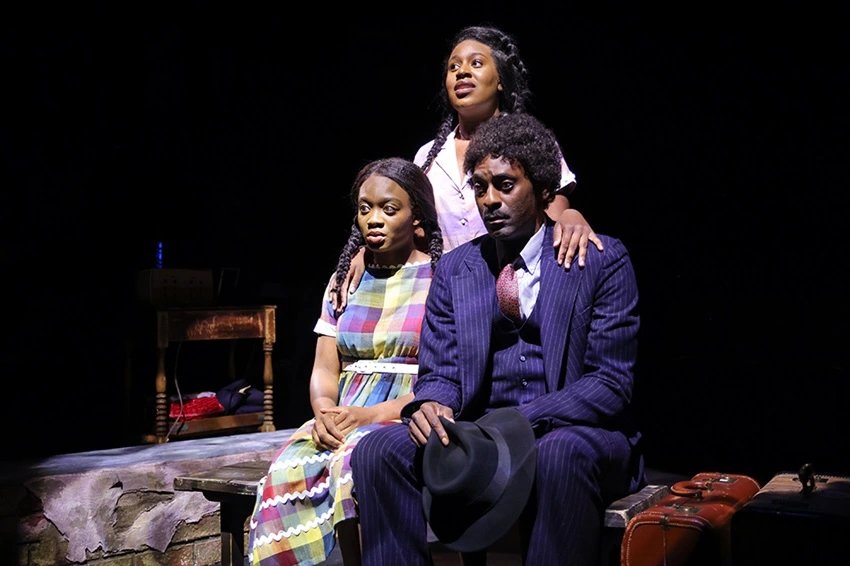PlayMakers Rep's Rendition of Lynn Nottage's Crumbs from the Table of Joy Is a Soul-Pinching, Conversation-Generating Production
This article was published by Triangle Review on 12 Sep 2024.
PlayMakers Repertory Company has picked Lynn Nottage's soul-pinching, conversation-generating Crumbs from the Table of Joy to kick off its 2024-25 season. Directed by Tia James and playing now through Sunday, Sept. 29th, in UNC-Chapel Hill's Paul Green Theatre, Crumbs from the Table of Joy is set in New York during the 1950's and centers on 17-year-old Ernestine Crump (played by Jadah Johnson), who is besotted with the films that enable her to escape the realities of her world: the loss of her mother; the resulting anger and religious zeal of her father; the uncompromising debauchery of her aunt, who has moved in with them; the white German woman whom her father marries -- all amidst the prejudice and self-imposed segregation of American society during the Civil Rights era.
Godfrey Crump, played by Nate John Mark, has saved himself from the grief of losing his wife by turning to religion and dedicating the rest of his life to the teachings of Father DIvine, the (real-life) leader of the Peace Mission Movement. Wanting to be closer to Father Divine (who claims that he's God), Godfrey moves his daughters -- Ernestine and her 15-year-old sister, Ermina (Mengwe Wapimewah) -- to Brooklyn, before discovering that Father Divine has relocated to Philadelphia. The family of three now lives in a small apartment in a majority Jewish neighborhood, where Godfrey works in a bakery.
Nate John Mark's delivery of Godfrey's newfound religious zeal rightfully renders Father Divine a main character, though his person never materializes. John Mark plays Godfrey with method-acting precision, invoking empathy and laughter with his strict rules and demeanor, despite his clear lack of control over the women in his home. Sometimes evoking Denzel Washington in the 2016 movie Fences, at other times John Amos in the 1970's sitcom Good Times, John Mark's laugh is contagious; and the earnestness with which he portrays Godfrey's rage-suppressed angst and desire to do well by his family is commendable.
The function of narrator dominates in Jadah Johnson's portrayal of Ernestine, whose character she imbues with youthful idealism and a desire to please, despite the hardships of her life.
Mengwe Wapimewah's facial expressions and body language personify the younger Ermina Crump's childlike enthusiasm, mischievousness, and naiveté with comical, though realistic, effect. She was my 14-year-oid son's favorite part of the production.
Towards the beginning of the play, an attractive black woman wearing stylish clothes that Ernestine and Ermina have only associated with white women, appears at the door. She is the girls' mother's sister, Lily Ann Green (Jasminn Johnson), a self-proclaimed Communist who drinks alcohol, listens to jazz, and goes dancing, all things that Godfrey has forsworn in allegiance to Father Divine.
Jasminn Johnson delivers Lily's informed and witty opinions with a streetwise and sexy candor that draws audience approval every time. Her appearance, demeanor, and dialogue delivery is delightfully like that of Jackée Harry in Another World, 227, Sister, Sister, and many other television series. At the same time, Jasminn Johnson infuses Lily's character with a tragic disillusionment reminiscent of Vivien Leigh's portrayal of sexy Blanche DuBois, who moves in with her sister and her husband in The 1951 classic film version of Tennessee Williams' 1947 play, A Streetcar Named Desire.
It isn't long before Lily's salaciously tempting behavior drives Godfrey to run away for a few days, during which he marries Gerte Schulte (Elizabeth Dye), a white German woman he meets on the subway. Godfrey later brags that he has a white wife just like Father Divine.
Dye expertly portrays Gerte, from her convincing accent to her self-conscious presence among the other women, who are not happy to be living with a white woman, despite the good will she appears to emanate. Dye brings out Gerte's lack of experience with American racism in every scene, a subtlety that is important to the themes of the play and their different impacts on a white German victim of WWII and the black members of her new American family.
Resident scenic and costume designer Jan Chambers' set is extensive. The ground stage convincingly depicts the humble interior of a family room and kitchen, complete with a vintage shortwave radio, refrigerator, cookstove, and sink, with curtained storage. But the magic is in the exterior staircases above and beyond center stage, so much are they like the fire-escape stairs of historic New York brownstones. Above and beyond the staircases are illuminated panels depicting windows, hard-backed chairs, and stairs composed of gold, black, and brown lines that are almost Cubist in nature. The backdrop is a work of art, in and of itself.
Crumbs from the Table of Joy is driven by dialogue, as opposed to plot, which -- at two hours long, with a 15-minute intermission -- can tire the audience by the play's end. Nonetheless, it is worth listening to everything that Lynn Nottage has to say regarding the disparate effects of racial bias and discrimination on both black and white people during the integration efforts of the 1950's. Though the play runs late, audience members should go out for a drink or dessert afterwards, so they don't miss the opportunity for open and honest discussion that Nottage has created.

